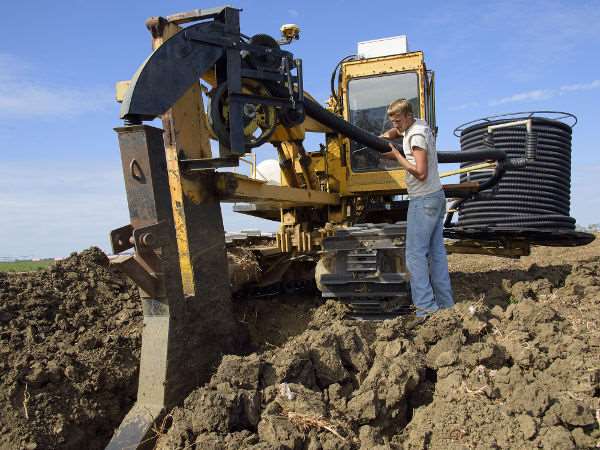By Dennis B. Reginelli

Dylan Yost feeds plastic tubing into equipment that buries drain tile in a deep furrow in fields. This Noxubee County field was being tiled Nov. 8, 2016.
Many farmers in east Mississippi are investing heavily in drain tiles that work like French drains in the landscape, and the result is higher productivity on land that previously was too wet.
Dennis Reginelli, a regional agronomic specialist with the Mississippi State University Extension Service in Noxubee County, said farmers are installing the flexible plastic tubing in the ground to drain away excess water.
“We usually have so much rain in the spring that producers are hampered getting into the fields to plant,” Reginelli said. “Drain tiles are used in wet areas to draw off the water, allowing low or wet spots to be planted at the same time as areas that naturally drain better.”
Plastic tubing is buried in farmland at precise depths and locations to drain off excess water from areas where too much moisture hampers crop yields. This drain tile was installed Nov. 8, 2016, at a Noxubee County field near Brooksville, Mississippi.
Marcus Jost, a Noxubee County farmer, said the biggest thing this system does is improve the internal drainage in a field.
“This allows the root system to establish at an early stage,” Jost said. “What I’ve seen with corn is when you get the crop that is not delayed or hampered by too much water, and its root system can develop, you’re miles ahead of yourself in a drought because you have a root system that is organized and can collect the nutrients and water that is available.”
Paul Good of Brooksville Farms helped his father lay drain tiles when he was a child growing up in the Midwest. Today, he has drain tile on much of his Noxubee County farmland.
“We’re installing drains in ground that is already in use, but the yields are so low,” Good said. “We might get 15 to 20 fewer bushels on the wet spots, where we get 150 to 200 bushels of corn elsewhere.”
Drain tiles work by preventing the soil from holding too much water. Most of the fields in east Mississippi that use drain tiles are also pivot irrigated. Producers who use the tiles report the two work very well together.
“Some people have the misconception that drain tiles take too much water out of the soil, so it gets dry,” Good said. “That’s a misconception because the drain tiles keep the ground percolating. A crop literally can drown out by not having enough air space around the roots.”
Dale Weaver, who farms with Good, said consistently wet sinkholes disappear in areas where drain tile is installed.
“It used to be when you planted corn, you would have to come back two or three weeks later and plant the wet spots,” Weaver said. “Last year, we put tile in there, and now you can’t even see where it used to be wet.”
Good said economics make the final decision on whether or not to install drain tile, but the yield advantage is significant.
“Data shows that getting the corn in two to three weeks early can improve the harvest by 15 to 25 bushels an acre,” Good said. “There’s so much advantage in the overall yield.”
Jost also offered proof of drain tile’s value in increased yields on his farm.
“This year when I was harvesting corn, I would say I saw a 15 to 20 percent increase in yield when I went over the areas of the field that had the drains,” Jost said. “Using tile allows you to take land that is almost unfarmable, and now you can farm it.”
Jody Giesbrecht installs drain tile in Noxubee County. He said installing tile costs about $700 to $1,200 an acre, with larger jobs costing less per acre than smaller jobs.
“A typical project that my customers are doing would be to tile the lower lying areas of a given field, maybe 25 to 40 percent of the field, so that it can be planted uniformly,” Giesbrecht said.
When hired to install tile, Giesbrecht first meets with farmers to learn their situations, including what areas have problems and where water tends to stand. Then he creates a detailed GPS topography map and designs the actual layout of the drainage system he installs. Tile in east Mississippi typically is buried about 2.8 feet deep, although it can vary from 2 to 3 feet deep.
Although the installing machine moves at 1.2 miles per hour, or 100 feet per minute, installation is a fairly quick process. Large numbers of acres are tiled in the fall, but tile can be installed while a crop is growing with limited destruction of plants.
“I tell customers to expect a 10-year payoff when they tile,” Giesbrecht said. “I expect to see most of Mississippi’s fields tiled in 25 years.”
Nathan Giesbrecht first installed drain tile four years ago and continues to install tiles on his Noxubee County farmland.
“The idea is to do the whole field someday, but I’m doing the lower ends first,” Nathan Giesbrecht said. “It has made the lower ends dry out faster than the tops of the hills, giving me very consistent yields and planting times.”
He estimated yields increase 20 to 25 percent in the areas with drain tiles, although common sense and actual experience indicate that wet growing seasons see a higher return than dry years.